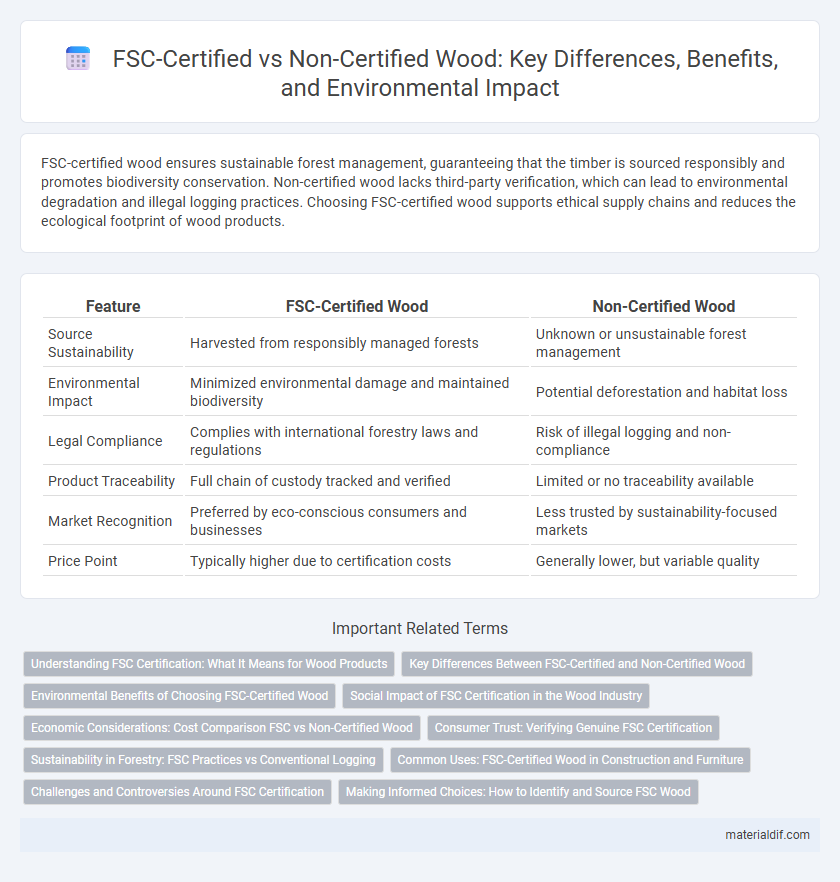FSC-certified wood ensures sustainable forest management, guaranteeing that the timber is sourced responsibly and promotes biodiversity conservation. Non-certified wood lacks third-party verification, which can lead to environmental degradation and illegal logging practices. Choosing FSC-certified wood supports ethical supply chains and reduces the ecological footprint of wood products.
Table of Comparison
| Feature | FSC-Certified Wood | Non-Certified Wood |
|---|---|---|
| Source Sustainability | Harvested from responsibly managed forests | Unknown or unsustainable forest management |
| Environmental Impact | Minimized environmental damage and maintained biodiversity | Potential deforestation and habitat loss |
| Legal Compliance | Complies with international forestry laws and regulations | Risk of illegal logging and non-compliance |
| Product Traceability | Full chain of custody tracked and verified | Limited or no traceability available |
| Market Recognition | Preferred by eco-conscious consumers and businesses | Less trusted by sustainability-focused markets |
| Price Point | Typically higher due to certification costs | Generally lower, but variable quality |
Understanding FSC Certification: What It Means for Wood Products
FSC certification ensures wood products come from responsibly managed forests that meet rigorous environmental, social, and economic standards. This certification promotes sustainable harvesting practices, biodiversity conservation, and protects indigenous rights, differentiating FSC-certified wood from non-certified counterparts often linked to deforestation and habitat loss. Choosing FSC-certified wood supports sustainable forestry and responsible supply chain transparency.
Key Differences Between FSC-Certified and Non-Certified Wood
FSC-certified wood comes from forests managed according to strict environmental, social, and economic standards, ensuring sustainability and responsible harvesting practices. Non-certified wood lacks this verification, which can lead to deforestation, habitat loss, and unethical labor conditions. Choosing FSC-certified wood supports biodiversity conservation, fair labor rights, and reduces illegal logging risks.
Environmental Benefits of Choosing FSC-Certified Wood
FSC-certified wood supports sustainable forest management by ensuring that forests are responsibly harvested, preserving biodiversity and ecosystems. This certification reduces deforestation, promotes carbon sequestration, and minimizes environmental impact through strict standards on logging practices. Choosing FSC-certified wood helps protect wildlife habitats and supports the long-term health of forest resources globally.
Social Impact of FSC Certification in the Wood Industry
FSC certification in the wood industry ensures responsible forest management that supports the rights and welfare of indigenous communities and local workers. Non-certified wood often lacks transparent social accountability, leading to potential exploitation and poor labor conditions. FSC-certified wood promotes fair wages, safe working environments, and community engagement, significantly improving social outcomes in forest-dependent regions.
Economic Considerations: Cost Comparison FSC vs Non-Certified Wood
FSC-certified wood generally carries higher upfront costs due to sustainable harvesting practices and certification fees, but it often leads to better market access and premium pricing. Non-certified wood tends to be cheaper initially, but it may face restrictions in certain markets and risks associated with environmental compliance. Over time, investing in FSC-certified wood can result in economic benefits through brand reputation, consumer preference, and reduced regulatory risks.
Consumer Trust: Verifying Genuine FSC Certification
FSC-certified wood ensures sustainable forest management verified by the Forest Stewardship Council, boosting consumer trust through transparent labeling and third-party audits. Non-certified wood lacks this rigorous verification, increasing the risk of illegally sourced or environmentally damaging products. Verifying genuine FSC certification guarantees authenticity, promoting responsible purchasing decisions and supporting global conservation efforts.
Sustainability in Forestry: FSC Practices vs Conventional Logging
FSC-certified wood ensures sustainable forestry by promoting responsible forest management, biodiversity conservation, and protection of indigenous rights, contrasting with conventional logging that often leads to deforestation and habitat degradation. FSC practices require rigorous chain-of-custody tracking, minimizing environmental impact and supporting long-term forest health. Non-certified timber lacks verified sustainability standards, posing higher risks of illegal logging and ecosystem imbalance.
Common Uses: FSC-Certified Wood in Construction and Furniture
FSC-certified wood is widely used in sustainable construction and high-quality furniture due to its verified source from responsibly managed forests. Builders and manufacturers prefer FSC-certified wood to meet environmental standards and appeal to eco-conscious consumers seeking durable, certified materials. Non-certified wood remains common in cost-sensitive projects but often lacks the assurance of sustainability and traceability inherent in FSC-certified products.
Challenges and Controversies Around FSC Certification
FSC-certified wood aims to promote sustainable forestry, but challenges include high certification costs and complex compliance for small-scale producers. Controversies arise over allegations of inadequate enforcement and disputes about the true ecological impact of some certified operations. These issues create skepticism among consumers and industry stakeholders regarding the credibility and effectiveness of FSC certification.
Making Informed Choices: How to Identify and Source FSC Wood
FSC-certified wood ensures sustainable forest management by meeting rigorous environmental, social, and economic standards verified by the Forest Stewardship Council. To identify FSC wood, look for the FSC label and a unique chain-of-custody code that guarantees traceability from forest to final product. Sourcing FSC wood supports biodiversity, reduces illegal logging, and promotes responsible forestry, making it a crucial choice for eco-conscious consumers and businesses.
FSC-Certified vs Non-Certified Infographic

 materialdif.com
materialdif.com